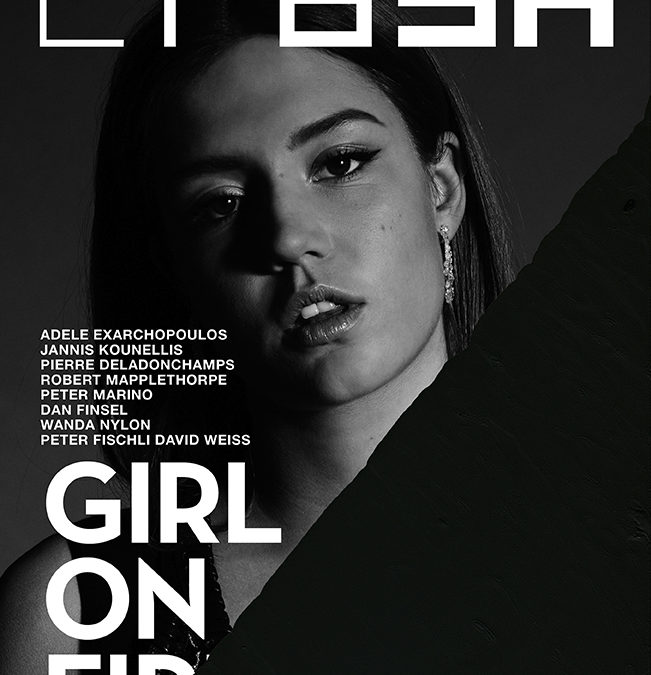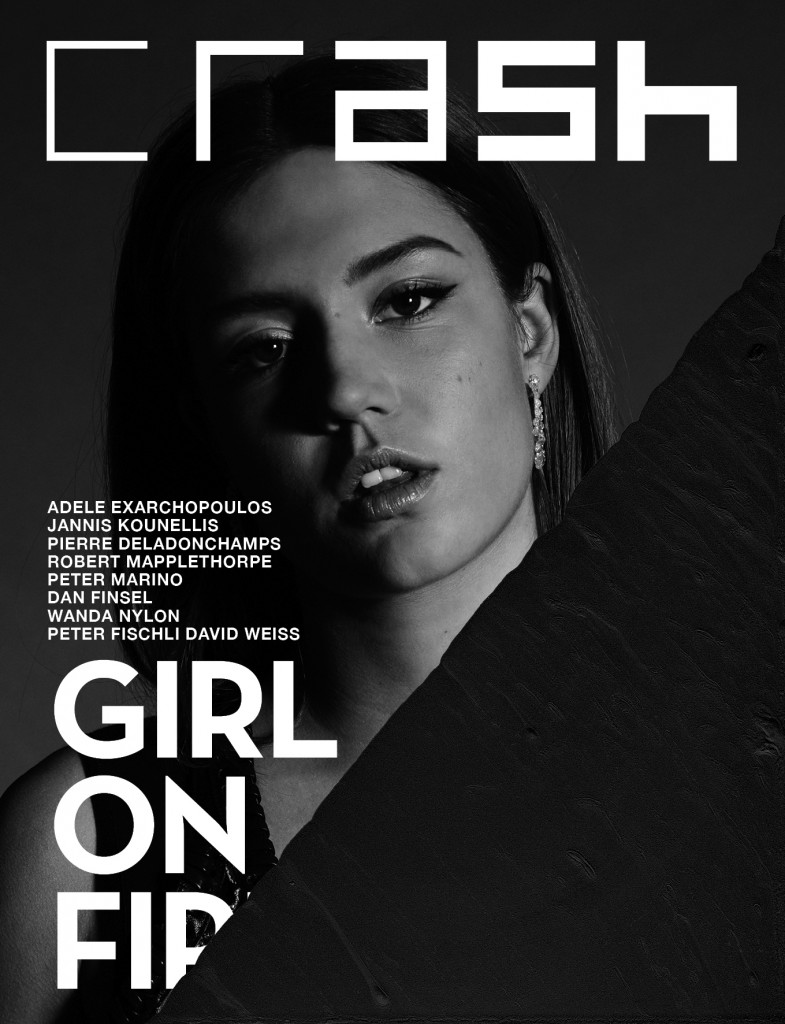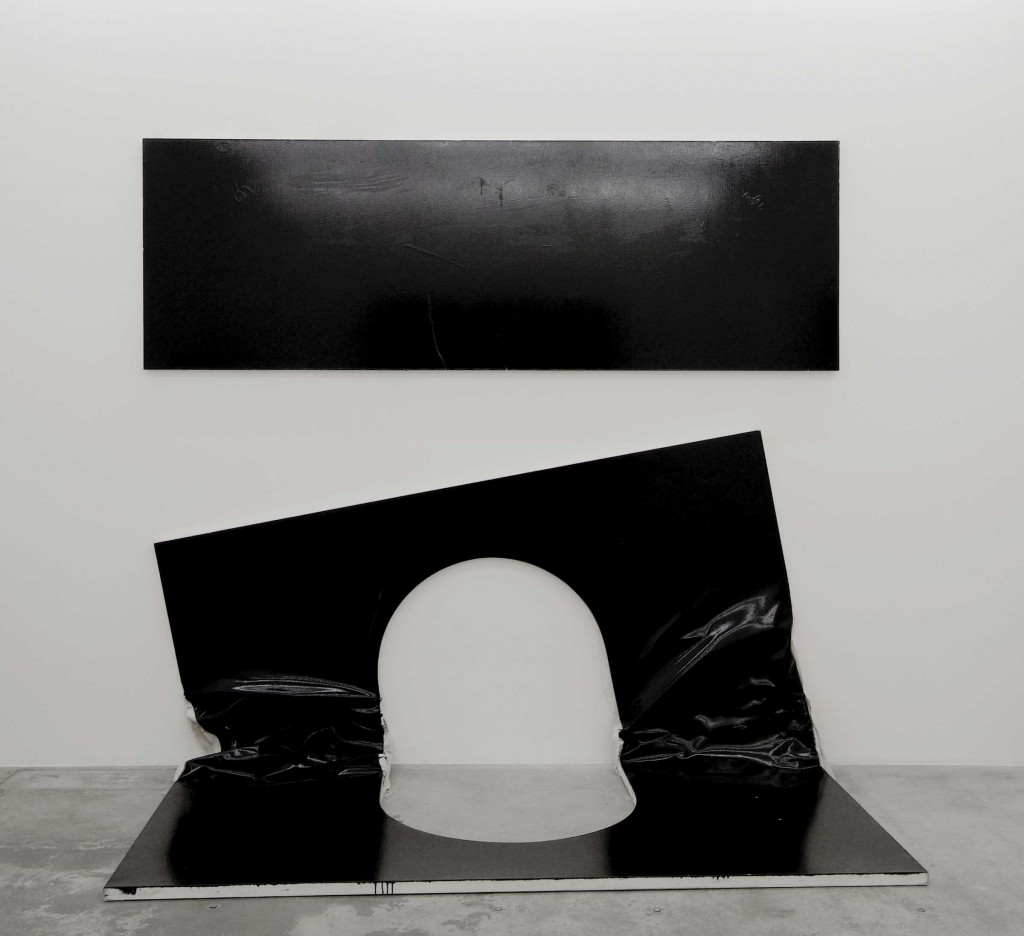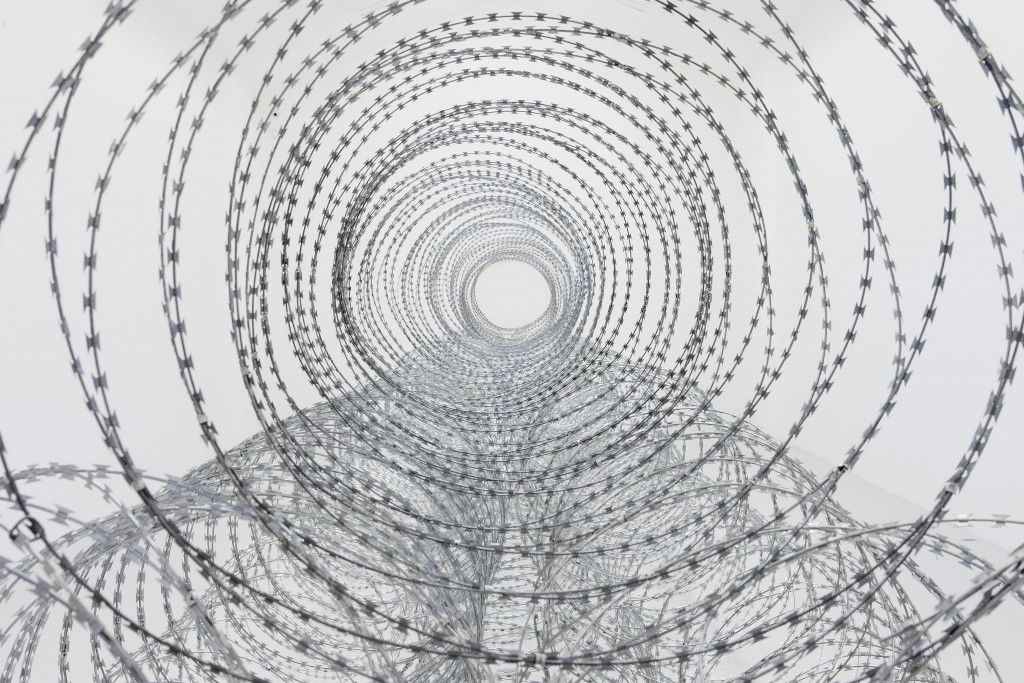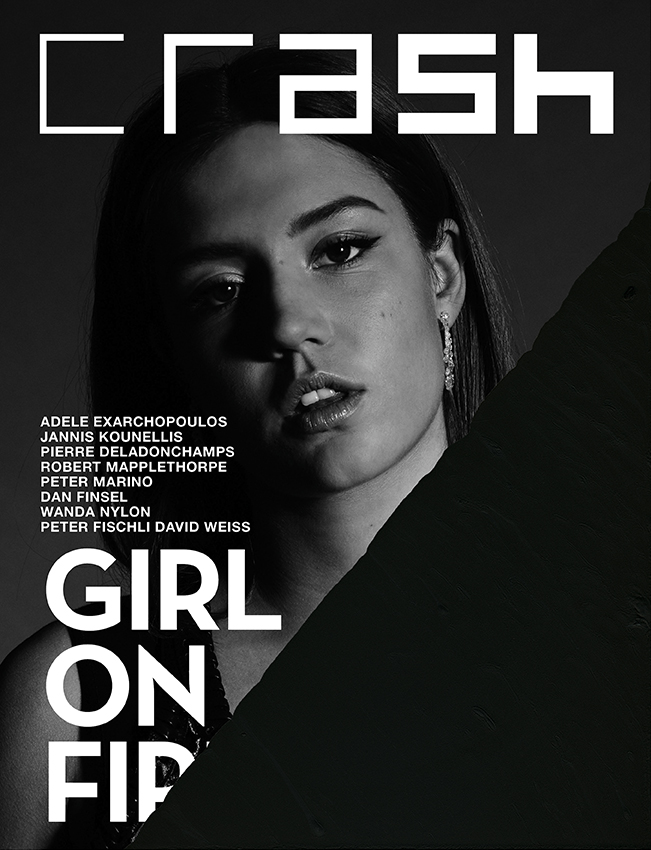
The cover of our issue 75 featuring Adèle Exarchopoulos and a special project by Jannis Kounellis.
CHIARA PARISI ON JANNIS KOUNELLIS
By Armelle Leturcq
On the occasion of the « Jannis Kounellis » retrospective at the Fondazione Prada, curated by Germano Celant, from May 11th through November 24rth, rediscover our interview with Chiara Parisi from 2016. At the time, she was the director of cultural programs at La Monnaie de Paris which was hosting an exhibition on the figure of Arte Povera. Kounellis even created a special visual for our issue 75 cover with Adèle Exarchopoulos.
Originally hailing from Rome, Chiara Parisi organized exhibitions at the Villa Medici prior to her seven-year stint as director of the Centre d’Art de Vassivière in Limousin. Today, she serves as the director of cultural programs at La Monnaie de Paris, where she has succeeded in bringing contemporary art into the magnificent building situated on the banks of the Seine in central Paris. Her projects have already generated a lot of buzz: witness last year’s Paul McCarthy exhibition and Broodthaers retrospective. Turning her attention now to the master of Arte Povera, Jannis Kounellis, she met with us to share her passion for “legendary artists” and Paris’s new contemporary art scene.
I saw that you did a project with Gianni Motti for Crash
He’s an artist I truly admire. I met him when I was at the Villa Medici; he took part in the “Tutto Normale” exhibition organized by Jérôme Sans and tried to reunite the Italian punk band Bloody Riot for a concert – it was great! Julie Pellegrin and I organized the Nuit Blanche festival in 2013 and we invited Gianni to do a project in Belleville based on his work about businessmen, called Spauracchio. I thought of him as a man of integrity; he never wanted to make any concessions when it came to his work. He really believes in it; he never quits; he’s incredible. Some collector friends of mine, the Gensollens, are huge fans of Gianni’s and they had him do a lot of work in Marseille.
Even though he is currently represented by Galerie Perrotin, he only shows the most radical projects like last year’s installation Draft, which he made with barbed wire.
Yes, but he doesn’t preach. He has high ideals but he isn’t preachy.
That’s completely true. So you first started at La Monnaie de Paris three years ago now.
That’s right. At first we mostly organized events like Mohamed Bourouissa and Bouba’s film for the Nuit Blanche festival, Stockhausen’s Helicopter String Quartet performed by the Elysian Quartet, Robert Pruitt’s flea market… Robert recreated an entire flea market inside La Monnaie de Paris! Our first big solo show was the Paul McCarthy exhibition, and then Marcel Broodthaers. We also did the group show Take Me (I’m Yours), and now Mister Kounellis!
Before you showed up there was never any art in La Monnaie.
The building is simply amazing – it’s one of the most beautiful buildings in France and I’m so fortunate to work there. La Monnaie de Paris is over three and a half acres in size; it still houses the foundry where we mint money; you can see the foundry’s industrial roof and the 18th century palace. The President of La Monnaie de Paris, Christophe Beaux, who was appointed in 2007, wanted to open the site up to the public and preserve the foundry. So he decided to show contemporary art on a regular basis. Our ambition was to present “mythical” artists, legendary artists, who for various reasons had not shown their work very often in Paris. Our programming focuses on specific skillsets and includes special projects. The most beautiful part of the palce is a 1,000-m2 area and it’s devoted to art. We also house Guy Savoy’s three-star restaurant in another part of the building. Guy Savoy had his side renovated by Jean-Michel Willmote. We kept our part in the original state, and even repainted it in imperial gray, just like it was, and removed the gilded borders. Then we simply asked, “Who are the top twenty artists we would love to exhibit?” At Vassivière I showed a lot of young artists. Here we work with more established names.
The Centre d’art de Vassivière is a magical place, and one that is completely isolated on a lake in central France. I went once a long time ago…
My team came with me from Vassivière; I needed my team of rebels! We spent seven years there; I lived in a little house across from the château on the Isle of Vassivière. We built artists residences there and the Koo Jeong-A skate park; I loved working there. But I really had to fight to work here; I was an outsider up against some of the top superstar curators. And against all odds I got the job!
If you can make it Vassivière, you can make it anywhere!
Yes! Because in Paris, the main question is audience and attendance. But my programming is still radical, even if it features many well-established artists. For the Kounellis show, we are right in the middle of the process; he is going to work with lead and traces of fire; our goal was to highlight the human side of the work. We want there to be some older pieces, which he calls “dramatic sculptures” since he does not like the term “installation,” or performance either. But we’d like to see some older pieces with a more ephemeral aspect, which is something that shows up a lot in his work. We’ve talked a lot about a piece he did called Marat and Robespierre, which is a painting on the theme of freedom that notably features a candle. We asked him to put together a big installation from scratch, with lead, scents, a dancer, or a pianist playing a Verdi piece. So he shot up and said to me: “I’m coming empty-handed like an old painter.” It’s magnificent, amazing! To say that at eighty. He spent a long time observing the space, its architecture, the floor, and the windows. I love him; he’s quite chic with his big cashmere coat. We’re very glad to have him. He’s going to come and set everything up on site. He’s truly one of the masters of Arte Povera…
Yes, but we don’t see much of him. He is extremely discreet and his work was never commercial.
That’s true, and he’s very attached to that aspect: the non-commercial side of his work. Even if Arte Povera is climbing in value today. He doesn’t like to talk about his old work either, because it’s impossible to recreate those pieces in the same way.
How about his legendary piece, Twelve Live Horses? Will he replicate that work at La Monnaie?
No, not in our space, but he did recreate it at Gavin Brown’s Enterprise in New York a year ago. It absolutely floored everyone! In the pictures it looks just like L’Attico in Rome in 1969. We’re editing an exhibition catalog and we’re going to place photos of the two works from 1969 and 2015 side-by-side. A lot of photos of his old works have been published. Kounellis once said to me, “Today, these pieces are no more than dreams.” The works have become dreams, myths, because it’s also no longer possible to recreate them due to safety concerns: the fire pieces, the gas cylinders, the woman with fire at her feet, etc. For us Kounellis is the same today as he was then. I asked him about his friends from back in the day, since we know he was close to Cy Twombly, who was living in Rome, and Mario Merz. You have to see how he moves around places; he has a certain melancholy about him. He still lives in Rome, and just reopened his studio on the Tiber. It’s a very elegant house but certainly not in a bourgeois way. It’s his old studio from the 1970s and there are a lot of his works and exhibition posters there. He also has a country house in Tuscany which is breathtaking, too. When he’s in Paris he loves going to Café de Flore… His project will focus mainly on freedom, the trace of fire, and human qualities – those are his three elements. We are also going to work with him to produce a coin. We created some marvelous coins with the artists who have exhibited here: Paul McCarthy, Rob Pruitt, James Lee Byars, Fabrice Hybert, Broodthaers, Baldessari, Pistoletto. Sterling Ruby loved our coins; we wanted to do something with him but it got delayed. We mint just two thousand models of each coin and sell them for only two euros! Chris Burden came here several times; we were supposed to do a project with him, too…
Chris Burden would have been perfect for La Monnaie de Paris. I remember McCarthy’s piece from the Place Vendôme. I saw it one morning and then the next day it was gone. I didn’t expect it to last long, especially in that neighborhood!
The police called me at five in the morning to tell me the work had been destroyed, though just the previous evening Paul and I were assaulted on Place Vendôme. We had just mounted the work and were on our way back to the museum when we were attacked! Especially Paul because the guards managed to protect me. He was all bloodied. But he didn’t want to press charges and he didn’t want to put the work back up after it had been damaged. Paul couldn’t understand the reason for such violence. Then there was the destruction of Anish Kapoor’s works in Versailles, too… It would have been better for everyone if we could have avoided the violence. Our next exhibition after Kounellis will feature Bertrand Lavier and Raymond Hains. We’re going from the seriousness of Kounellis to the humor of Bertrand Lavier and Raymond Hains.
It’s great to see Raymond Hains’ work getting a second wind today. How did you go about tracking down his works?
Galerie Max Hetzler in Paris worked hard to find his pieces and Bertrand Lavier knows Raymond Hains’ work very well. Eric Fabre in Brussels, who also owned the gallery in Paris and worked with Raymond Hains, also has a lot of his work.
Raymond Hains was an incredible person. I remember meeting him a few times when he lived in the Hôtel de la Paix in Montparnasse. He never wanted to live in an apartment. He made films and worked in tandem with Jacques Villeglé when they were younger. Villeglé is a quite an interesting person, too. I interviewed him about a year ago for Crash. The 1970s were an exciting time in France, though the artists never quite broke into the international scene. There was so much competition from the United States, with Pop Art changing everything, and there were not enough strong galleries in France to support the artists. Even with the art critic Pierre Restany promoting that movement of neo-realist artists, their work was never commercial – just like Kounellis.
Yes, just like in Italy with Arte Povera, things were tough for those artists in France, too. Art in France was also extremely intellectual: painting was almost taboo. The Lavier and Hains exhibition will start in late May and last until July; we like to emphasize the ephemeral side of things in our exhibitions. So we are going to completely transform the space: there is going to be a garden, and a passageway inside the Hôtel de la Monnaie where visitors can walk through the building to get from one street to the other. We also have a mint outside of Bordeaux in Pessac where we put on interdisciplinary projects; it’s called Factory. We had invited Chantal Ackerman to make a film there. What a tragedy to lose her! I nominated her to produce the French pavilion at the Venice Biennale. She submitted a stunning project based on the Mediterranean and wrote everything out by hand. She was heartbroken that her project didn’t get selected. We are going to do a tribute to her with artist Rosa Barba, who is also on this year’s Factory program. She is going to put together a new work in homage to the director. It will be a collaborative work with the CAPC, where Rosa is presenting a solo exhibition in Fall 2016.






